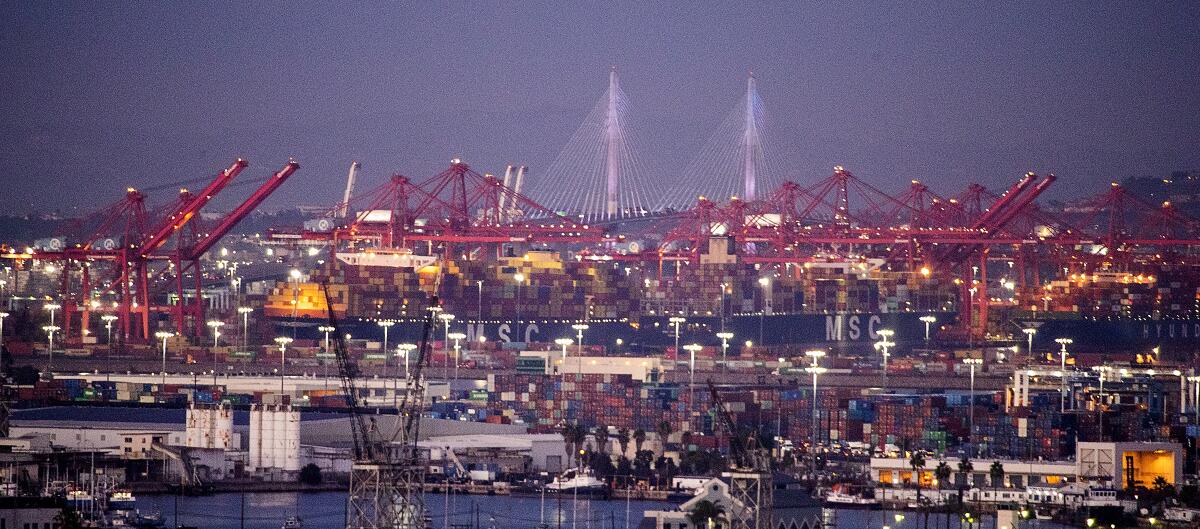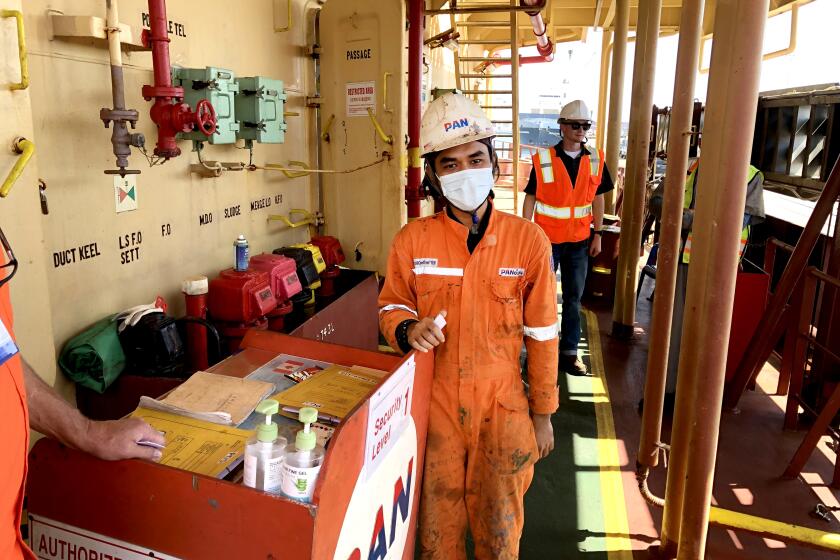Newsom, Buttigieg announce $5 billion in loans for California’s clogged ports

- Share via
Not content to wait for Congress to pass a big infrastructure spending bill, Gov. Gavin Newsom and U.S. Transportation Secretary Pete Buttigieg moved on Thursday to inject $5 billion in loan money to help modernize California’s seaports.
The money won’t help unclog the severe congestion that’s creating seaport chaos at present, but the two say that modernizing the ports and the truck and rail systems that serve them can prevent logistics nightmares in the future.
For the record:
2:43 p.m. Oct. 28, 2021An earlier version of this article misspelled the last name of John D. Porcari.
“Our supply chains are being put to the test, with unprecedented consumer demand and pandemic-driven disruptions combining with the results of decades-long underinvestment in our infrastructure,” Buttigieg said in a statement. “Today’s announcement marks an innovative partnership with California that will help modernize our infrastructure, confront climate change, speed the movement of goods and grow our economy.”
What the money would be spent on remains vague. The California State Transportation Agency, or CalSTA, listed port upgrades, more freight rail capacity, increased warehouse storage, truck and rail electrification, highway upgrades and other general categories as possibilities. At a news conference Thursday, John D. Porcari, President Biden’s point person for addressing supply chain problems, and CalSTA Secretary David S. Kim each likened the program to “a hunting license.”
The loan money would come from existing U.S. Transportation Department programs that offer easy terms, including low rates of interest, loan guarantees and long payback periods, as well as some state money and public-private financing.
CalSTA said Thursday that the agreement “allows California to expedite work on a network of related projects — rather than using a piecemeal approach — that collectively will help grow the economy, improve the environment, facilitate the movement of imports and exports, and strengthen supply chain resilience throughout the U.S. and California’s critical trade corridors, including around San Pedro Bay and the Inland Empire.”
No details were offered on what constitutes that network, nor was it clear how the loans will be disbursed, or to whom.
This month, Newsom ordered state agencies to develop longer-term proposals to support port operations and movement of goods, to be considered for his January 2022 budget proposal.
This year, the state budget includes $250 million for ports, $280 million for infrastructure projects at and around the Port of Oakland, and $1.3 billion over three years for zero-emission transit buses, school buses and trucks, including more than 1,000 port drayage trucks.
The current logistics tie-ups aren’t unique to California. Ports around the world clogged as demand surged for shipped products over the last year, in large part because of the availability of COVID-19 vaccinations that pushed economic activity back toward normal.
But longer-term issues plaguing California ports threaten not just the state but the entire U.S. economy. The San Pedro Bay ports — Los Angeles and Long Beach — move about 40% of all containerized cargo entering the U.S. each year and about 30% of containerized exports.
They’ve been stuck for months on cargo ships now floating off Southern California. They’re desperate
On ships caught in the huge floating traffic jam off L.A., seafarers with scant access to vaccines have been stuck in limbo for months. Unions tell of despair and violence.
The ports are under tremendous strain as overall container traffic in the nation’s largest ports has increased by 47% since 2010, according to Logistics Management magazine.
Meanwhile, delays at the ports of Los Angeles and Long Beach have been increasing at least since 2014, according to data from the Harbor Trucking Assn.
California’s ports face increasing competition from southern and eastern U.S. ports, some of which are making big investments in port modernization, prompted by an expansion of the Panama Canal in 2016 that widened capacity and boosted import traffic from China and other Asian nations.
The Port of Houston recently widened its channels and added taller cranes, while adding new automation systems for routing containers and managing inventory.
The word “automation” was not mentioned in Thursday’s official announcement. Port automation is a fraught topic in California. The local International Longshore and Warehouse Union has been fighting it for decades.
In 2019, the union marched against implementation of an automation project at Pier 400 and showed up en masse at harbor commission meetings to protest. In May, the union announced its opposition to a plan to automate Long Beach’s largest terminal.
Last year, the state Legislature passed a bill that created a 10-member commission to study ways “to mitigate the employment impacts of automation” at the Los Angeles and Long Beach ports.
A 2018 report by the consulting firm McKinsey & Co. reviewed automation projects at ports around the world and concluded that many projects turned out less productive than expected, in part because outmoded manual practices were automated, rather than new systems and work processes being designed from scratch to take full advantage of the benefits of automation. The report also said the industry has done a poor job of data standardization.
McKinsey noted that the same problems sank auto industry automation efforts in the 1980s until unions and management joined forces to increase use of robotics and modern data systems.
The Biden administration’s Porcari said the administration is taking a two-pronged strategy: First, try to alleviate the ongoing congestion at ports that has left cargo ships idling off the coast of California, then lay the groundwork for future improvements.
This latest announcement falls into the latter category, and the benefits may not be apparent for years to come.
Porcari said the stress of the pandemic has revealed how the country’s infrastructure has lacked improvements for years.
“The essential problem is we’re working with our grandparents’ infrastructure investments,” he said. “It just doesn’t work.”
More to Read
Inside the business of entertainment
The Wide Shot brings you news, analysis and insights on everything from streaming wars to production — and what it all means for the future.
You may occasionally receive promotional content from the Los Angeles Times.













